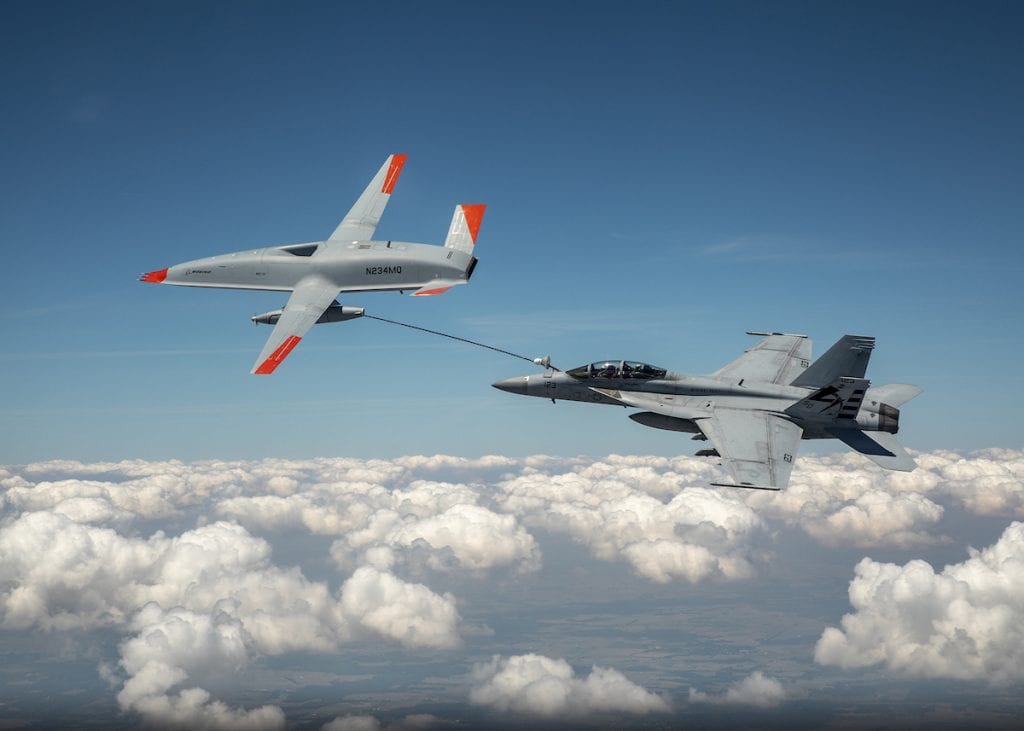
The Boeing MQ-25 T1 test asset transfers fuel to a U.S. Navy F/A-18 Super Hornet on June 4, marking the first time in history that an unmanned aircraft has refueled another aircraft. The MQ-25 Stingray will assume the carrier-based tanking role currently performed by F/A-18s, allowing for better use of the combat strike fighters and helping extend the range of the carrier air wing. (Photo: Kevin Flynn)
SAN DIEGO – The Navy Air Boss on Jan. 28 confirmed the first MQ-25A Stingray aircraft carrier-based unmanned tanker aircraft will start test flying later this year, a necessary step to getting to future manned-unmanned teaming systems.
“We will fly MQ-25 in ‘25. You can quote me on that, we will fly that platform in ‘25 and get that thing on the carrier in ‘26 and start integrating that thing. That unlocks the future of manned-unmanned teaming, which is number two in the NAVPLAN for [Chief of Naval Operations] Adm. Franchetti,” Vice Adm. Daniel Cheever, commander of Naval Air Forces and Naval Air Force – U.S. Pacific Fleet, said during the WEST 2025 conference, hosted by AFCEA and the U.S. Naval Institute.
The Navy first awarded Boeing [BA] an $805 million engineering and manufacturing development (EMD) award in 2018 to design, develop, build, test and verify the first four MQ-25s.
The Navy plans to ultimately produce 76 MQ-25s, including four engineering development models and five system demonstration test articles.
Last April, Rear Adm. Stephen Tedford, program executive officer for unmanned aviation and strike weapons, confirmed the Navy plans the first MQ-25 to conduct its first flight in spring 2025 at Naval Air Station Patuxent River in Maryland and achieve initial operational capability (IOC) in 2026 once it is integrated with a carrier.
The service wants to use the MQ-25 to relieve F/A-18E/F Super Hornets that are relegated to the tanking mission. Replacing them with the MQ-25 is expected to open up more fighters for training and combat.
Cheever said the main part of using MQ-25 is for the tanking mission to extend long-range strikes, but hinted at how “there’s a lot of future potential capability there, won’t go any further than that, but there’s a lot of potential there.”
He may have been alluding to how the Stingray was previously billed as also having some intelligence, surveillance and reconnaissance (ISR) capabilities, secondary to its tanking mission.
When asked about any potential growing pains combining the MQ-25 with the carriers, Cheever said “I don’t see a lot of issues bringing it together. First thing is you’ve got to get the thing flying and second thing you’ve got to get it on the carrier with the Unmanned Control Station that we already have on the carrier, waiting for that platform. So really excited to get that going.”
Last August the Navy confirmed it installed the first Unmanned Air Warfare Center (UAWC) on the USS George H.W. Bush (CVN-77), where operators will control the MQ-25. The UAWC has the equipment that makes up the first operational and integrated Unmanned Carrier Aviation Mission Control System (UMCS) MD-5E Ground Control Station (GCS).
Cheever said a big part of making the MQ-25 work will be how he plans to “turn the weapons tactics instructors loose” so they can figure out how exactly to operate the aircraft and add more manned-unmanned teaming experience that opens up future unmanned missions.
Cheever also underscored getting the MQ-25 started will help build the Navy’s confidence to continue building more manned-unmanned teaming capabilities, but he pointed out they are already working on this with the P-8A Poseidon and MQ-4C unmanned aircraft for the persistent maritime ISR mission for long-range anti-submarine warfare.
He said adding a successful MQ-25 manned-unmanned teaming based on carriers will lead to a “different world, it opens up the future of sixth generation Collaborative Combat Aircraft and everything that comes after it.”
Cheever said those will likely be some of the capabilities on the future aircraft carriers CVN-79, 80 and 81 that are expected to operate into the 2080s.
Cheever noted both the MQ-4 and upcoming MQ-25 lessons learned are being, and will be shared, with the surface, subsurface portions of the Navy, and Air Force “in how these things work, so we’re pretty excited about it.”
MQ-25 production and timelines have been delayed several times. In 2023 a DoD Office of the Inspector General report noted the MQ-25 schedule was pushed back due to production maturity issues and requiring more testing before moving to production.
According to the FY 2025 budget request documents, the Navy plans for MQ-25 initial test and evaluation to last from the third quarter of FY 2024 to the end of FY 2027, initial operation test and evaluation in the first half of FY 2027, and IOC in the fourth quarter of FY 2026.
The Milestone C decision is now due to be reached by the third quarter of FY 2025, with a low-rate initial production contract for the first non-developmental aircraft in June 2025.
A version of this story originally appeared in affiliate publication Defense Daily.